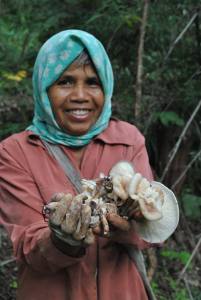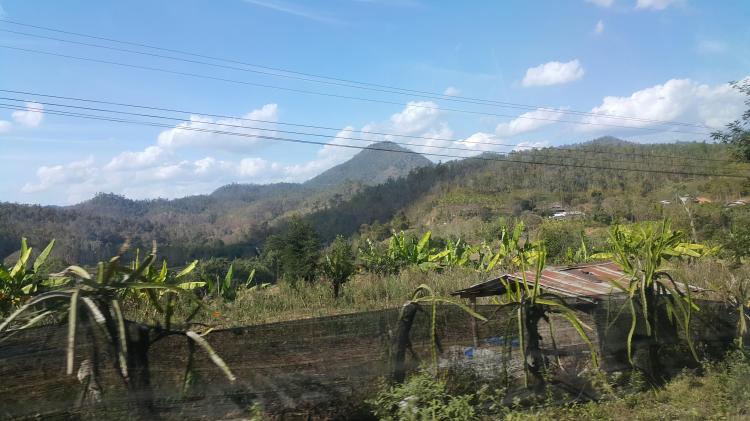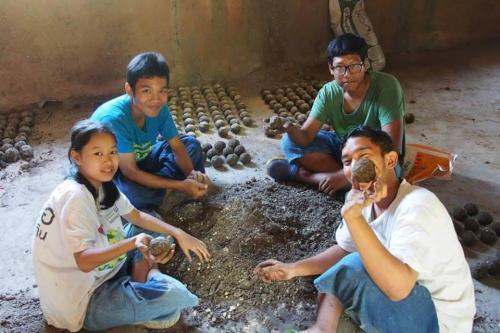Eco-Temple: Built small and ecologically from ancient Buddhist tradition of forest hermitages–>
Surrounding Environment: Regeneration of water table/watershed by building check dams–> Reforestation and rehabilitation of environment–>
Education for Ecology and Dharma: establishment of eco-school in which children learn about practical livelihood, environment, and sufficiency values–>
Sufficiency Economy: Planting and harvesting forest products for self-sufficiency and marketing ecological products likes soaps, shampoos, etc.–>
Community Development: adults follow children, government authorities join in support
Energy Sector: UNTAPPED POTENTIAL micro-hydro for electricity
Case Study in Using Check Dams and Reforestation to Build Ecological Communities
As a young man before ordaining as a Buddhist monk, Phra Sangkom Thanapanyo Khunsiri came under the influence of INEB Founder Ajahn Sulak Sivaraksa, through whom he also came to learn of the community development work in his own region of Surin in Northeast Thailand by Luang Po Nan, Thailand’s first prominent development monk. After ordaining, Phra Sangkom established in 2006 a small temple called Wat Doi Pasom (the Temple of Buddha Relics) in a mountainous region of Chiang Mai province. In national forest reserves owned by the Thai government, usually no one is allowed to live, but because of ancient tradition, Buddhist monks are allowed to live in small temples in such forests.
At first, he faced many challenges because the land was so degraded from deforestation and intensive chemical based agriculture. Large companies like Monsanto and CP Food Co. had clear cut the forests to plant corn. They were also many kinds of people who tried to enter the forest to cut down the trees. In this way, the watersheds had dried up and the forests became prone to forest fires. Phra Sangkom spent much of his first years there fighting these fires.
Based on the Theravada Buddhist ethics of non-harming, he lived by the principle of not cutting any trees, though he had to cut some small ones for basic practical purposes for establishing his temple. Beyond maintaining his own living situation at this small hermitage, he also felt a responsibility for the people in the area, who were living in poverty and facing water shortages. Even digging down deep into the ground, they could not find water. He recalls that in order to solve this problem, he looked towards the late Thai King Bumipon’s guideline that if you have no water, you build a check dam. A check dam is a very small, hand made dam, which can catch rainwater as it flows off the mountain. Because of the total degradation of the land from commercial interests in many places now, like with our eco-temple colleagues in Myanmar, when the rainy season comes, the water floods off the mountain leaving huge areas of mud and ruined land. It’s almost impossible to rehabilitate the land for any purpose. Phra Sangkom and his group thus first built check dams at the top of the mountain to contain such rainwater and regulate it. This helped to restore the watershed and enabled them to plant trees and eventually rehabilitate the land.
In this way, Phra Sangkom and his group have tried to safeguard quite a wide swath of land of about 100,000 acres. He taught the locals that since so much of their livelihood comes from the forest, they should not burn it. However, the people didn’t really understand this and the importance of the jungle for their lives. This problem thus became the basis of creating an alternative school in the jungle. Phra Sangkom explains that generally, for people in the countryside, parents dream that their children will go to good government schools and then got to Bangkok or Chiang Mai to become successful in professional careers. In discussions with local government officials, he would tell them that the government schools are not good for their community, because when a child goes to a government school, they leave home and never come back. As an alternative, he established what he calls an eco-university on the top of the mountain at his temple. It’s a kind of homeschooling, like a temple homeschool.
The children who start here as early as ten years old do not go to regular government schools, but work and study at the temple everyday. It is a free school in which they learn by doing and can earn income from the products they make here like soap, shampoo, organic compost, and oil. Phra Sangkom explains that each student must learn how to act on their own by studying how to protect the forest, how to plant the right kinds of trees and plants for their own self-sufficiency, and then develop eco-products. Phra Sangkom didn’t preach Buddhist ideas to them directly. Rather, like our eco-temple colleague Rev. Hidehito Okochi in Japan, he practiced the Buddhist method of the Four Noble Truths: they began with looking at the problem and analyzing it; this led to the proper wisdom and proper steps and the rest of the path emerged. His motto is to develop the mind and to develop Right Wisdom/View (samma ditthi) along with Right Economy. He says economy and mind have to develop together to attain Nirvana.
 It took him 8 years to fully communicate these ideas to the local people and to have the government understand his work. When he first opened this school, he was accused to being a Communist, and the authorities arrested him 12 times. They accused him of destroying the forest. The government said the local people are not allowed to enter the forest to collect food, like wild mushrooms, or engage in any cultivation. Phra Sangkom told the government authorities that if they cannot do so, they will end up burning the forest to make a different use for it. He urged the people to reforest, to plant trees, and he also told the government to allow the people to engage in such reforestation activities. He also had to work with the ministry of education, because they didn’t want to recognize such a school.
It took him 8 years to fully communicate these ideas to the local people and to have the government understand his work. When he first opened this school, he was accused to being a Communist, and the authorities arrested him 12 times. They accused him of destroying the forest. The government said the local people are not allowed to enter the forest to collect food, like wild mushrooms, or engage in any cultivation. Phra Sangkom told the government authorities that if they cannot do so, they will end up burning the forest to make a different use for it. He urged the people to reforest, to plant trees, and he also told the government to allow the people to engage in such reforestation activities. He also had to work with the ministry of education, because they didn’t want to recognize such a school.





